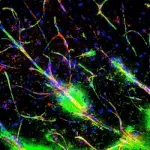(Press-News.org) Handwashing is shaping communities of bacteria that live and grow in the plumbing of domestic sinks, scientists have found.
In the largest study of sink bacteria conducted outside of hospitals, scientists at the University of Reading discovered communities of similar bacteria that largely remain down our drains after hand washing.
The researchers found that there are significant differences between families of dominant bacteria depending on the location in the sink drains, and that plumbing systems such as P-trap or U-bend provides ideal environments for bacteria to grow.
Dr Hyun Soon Gweon, Lecturer in Bioinformatics for Genomics at the University of Reading, said:
"The mantra to 'wash your hands' to fight coronavirus transmission has highlighted the importance of not only good hand hygiene, but also the need for well-designed and regularly cleaned sinks.
"Our study reveals that the significant difference in bacterial families between different buildings shows that a number of factors including occupancy and building design may have a big influence on the types of bacteria we come into contact with."
Samples were taken from 123 sinks around non-clinical settings at the University of Reading - such as toilets and bathrooms in teaching, research and social spaces - and show that sinks have a distinct microbiome dominated by certain bacteria.
The plumbing area found beneath sinks revealed microbial communities dominated by a group of bacteria called Proteobacteria. This phylum includes pathogens such as Salmonella and E. coli, which can cause serious disease, although the proportion of bacteria from that family was low. Higher concentrations were found of the common Moraxellaceae and Burkholderiaceae bacteria, which can cause infections but are mostly harmless to humans.
The type of plumbing system had a significant effect on which family was more abundant. Below- sink strainers were found to have Moraxellaceae bacteria, while P-trap sinks, which have a P-trap style of drainage, had higher amounts of Burkholderiaceae.
Lead author of the study Zoe Withey, a PhD researcher at the University of Reading, said:
"The bacteria that live in our sink drains are shaped by what we are directly putting down them. While we expected that bacteria from the gut would have a greater impact, caused by the wider environment of a bathroom, it seems that by and large the bacteria living on the skin of our hands are feeding the community in the drains beneath sinks.
"This means that we need to be very aware that what we are putting down our sinks is affecting the bacterial community underneath. These areas may not be reached during routine cleaning, and this could lead to communities containing hardier, resistant microbes."
The scientists point out that all the sinks where samples were taken were regularly cleaned.
Dr Gweon said:
"We hope our findings will remind people that the bacterial on your hands often stay alive and capable of growing even after they have been washed off, even in the presence of soap and warm water. It is possible to spread bacteria to the surrounding areas of your sink, where they can grow and persist. Reducing transmission of bacteria requires thorough disinfection of the sinks and surrounding areas and not just getting your hands wet."
The study was conducted in 2019, prior to the global pandemic caused by Covid-19 and so there is no direct influence of increased handwashing or other hygiene behaviour associated with the pandemic on this study. However, the authors point out that the significance of bacteria from the skin means that handwashing will be having a significant effect on the bacterial communities of our sinks.
INFORMATION:
Full citation:
Withey Z, Goodall T, MacIntyre S, Gweon H. Characterization of communal sink drain communities of a university campus. Environmental DNA. 2021;00:1-11. https://doi.org/10.1002/edn3.196
COVID-19 could pass into people's lungs from saliva with the virus moving directly from mouth to bloodstream - particularly if individuals are suffering from gum disease, according to new research.
Evidence shows that blood vessels of the lungs, rather than airways, are affected initially in COVID-19 lung disease with high concentrations of the virus in saliva and periodontitis associated with increased risk of death.
The researchers propose that dental plaque accumulation and periodontal inflammation further intensify the likelihood of the SARS-CoV-2 virus reaching the lungs and causing more severe cases of the infection.
Experts say this discovery could make effective oral healthcare ...
General anaesthesia is widely used for surgery and diagnostic interventions, to ensure the patient is completely unconscious during these procedures. However, in a paper published in Anaesthesia (a journal of the Association of Anaesthetists) ethics and anaesthesia experts from the University of Oxford say that general anaesthesia should be more widely available for patients at the end of their lives.
Painkilling medications (analgesia) are commonly given to dying patients. But they may not be enough, leading to the use of continuous deep sedation (also known as "palliative" or "terminal" sedation).
"However, for some patients these common interventions are not enough. Other patients may express a clear desire to be completely unconscious as they die," explains ...
In 2003 in Haiti, a 20-year-old in treatment for HIV could have expected to live to 34. But as of 2017, life expectancy for a 20-year-old in treatment for HIV in Haiti is now 61, compared to 70 for Haiti's general population.
A research team from Vanderbilt University Medical Center and institutions across Latin America today reports what looks to be far the largest study to date of life expectancy for people living with HIV infection in low-income or middle-income countries.
With a focus on 30,688 people treated for HIV between 2003 and 2017 in seven Latin American countries, the study, published ...
Study of 30,000 adults living with HIV receiving antiretroviral therapy (ART) in Latin America and the Caribbean finds life expectancy has increased to within 10 years of the general population in these countries over the last two decades.
Disparities in life expectancy due to demographic and clinical factors at the point participants began ART (including sexual HIV transmission risk, low CD4 cell count, and history of tuberculosis) highlight an ongoing need to reach vulnerable populations in the region.
Life expectancy among adults living with HIV receiving antiretroviral therapy (ART) ...
When disease outbreaks happen, response time in developing and distributing treatments is crucial to saving lives. Unfortunately, developing custom drugs as countermeasures is often a slow and difficult process.
But researchers at the University of Colorado Boulder have created a platform that can develop effective and highly specific peptide nucleic acid therapies for use against any bacteria within just one week. The work is detailed in Nature Communications Biology and could change the way we respond to pandemics and how we approach increasing cases of antibiotic resistance globally.
The Facile Accelerated Specific Therapeutic (FAST) platform was created by Associate Professor Anushree Chatterjee ...
Researchers at the University of Jyväskylä highlight how the struggles caused by the COVID-19 pandemic can guide us towards an equitable use of our shared environment and a transition towards sustainability.
COVID-19 crisis has emphasized how poorly prepared humanity is to cope with global disasters and to face the new ecological norm under climate change, degraded ecosystems, and biodiversity loss. The final consequences of COVID-19 crisis on sustainability are not yet known. However, this crisis offers a unique opportunity to move towards a greener, ...
Coral reefs around the world are under threat from rising sea temperatures, ocean acidification, disease and overfishing, among other reasons.
Tracking signs of stress and ill health is difficult because corals -- an animal host coexisting with algae, bacteria, viruses and fungi -- are dynamic organisms that behave differently depending on what's happening in their environment. Some scientists wonder if recording changes in coral movements over time could help with monitoring a coral reef's health.
This is not always a straightforward task. Some coral species wave and pulse in ...
Just as e-cigarette ingredients can vary from one region to another, the health effects of vaping can have regional characteristics as well. A new study out of West Virginia University suggests that rural e-cigarette users are older--and often get sicker--than their urban counterparts.
Researchers with the WVU School of Medicine are investigating severe lung injuries occurring among e-cigarette users in rural Appalachia. In a recent study, Sunil Sharma--section chief of pulmonary/critical care and sleep medicine at the School of Medicine--and his colleagues present a case study of patients with EVALI (electronic cigarettes and vaping-associated lung injury) admitted to WVU hospitals from August 2019 to March 2020. ...
Like a stern bodyguard for the central nervous sytem, the blood-brain barrier keeps out anything that could lead to disease and dangerous inflammation--at least when all is functioning normally.
That may not be the case in people with schizophrenia and other mental disorders, suggest new findings from a team led by researchers from the School of Veterinary Medicine, Perelman School of Medicine, and Children's Hospital of Philadelphia (CHOP). In these individuals, a more permissive barrier appears to allow the immune system to get improperly involved in the central nervous system, the researchers showed. The inflammation that arises likely contributes to the clinical manifestations of neuropsychiatric conditions.
"Our hypothesis was that, if the immune function of the blood-brain ...
WASHINGTON -- Researchers have developed new x-ray optics that can be used to harness extremely fast pulses in a package that is significantly smaller and lighter than conventional devices used to modulate x-rays. The new optics are based on microscopic chip-based devices known as microelectromechanical systems (MEMS).
"Our new ultrafast optics-on-a-chip is poised to enable x-ray research and applications that could have a broad impact on understanding fast-evolving chemical, material and biological processes," said research team leader Jin Wang from the U.S Department of Energy's Argonne National Laboratory. "This could aid in the development of more efficient solar cells and batteries, advanced computer storage materials and devices, ...





